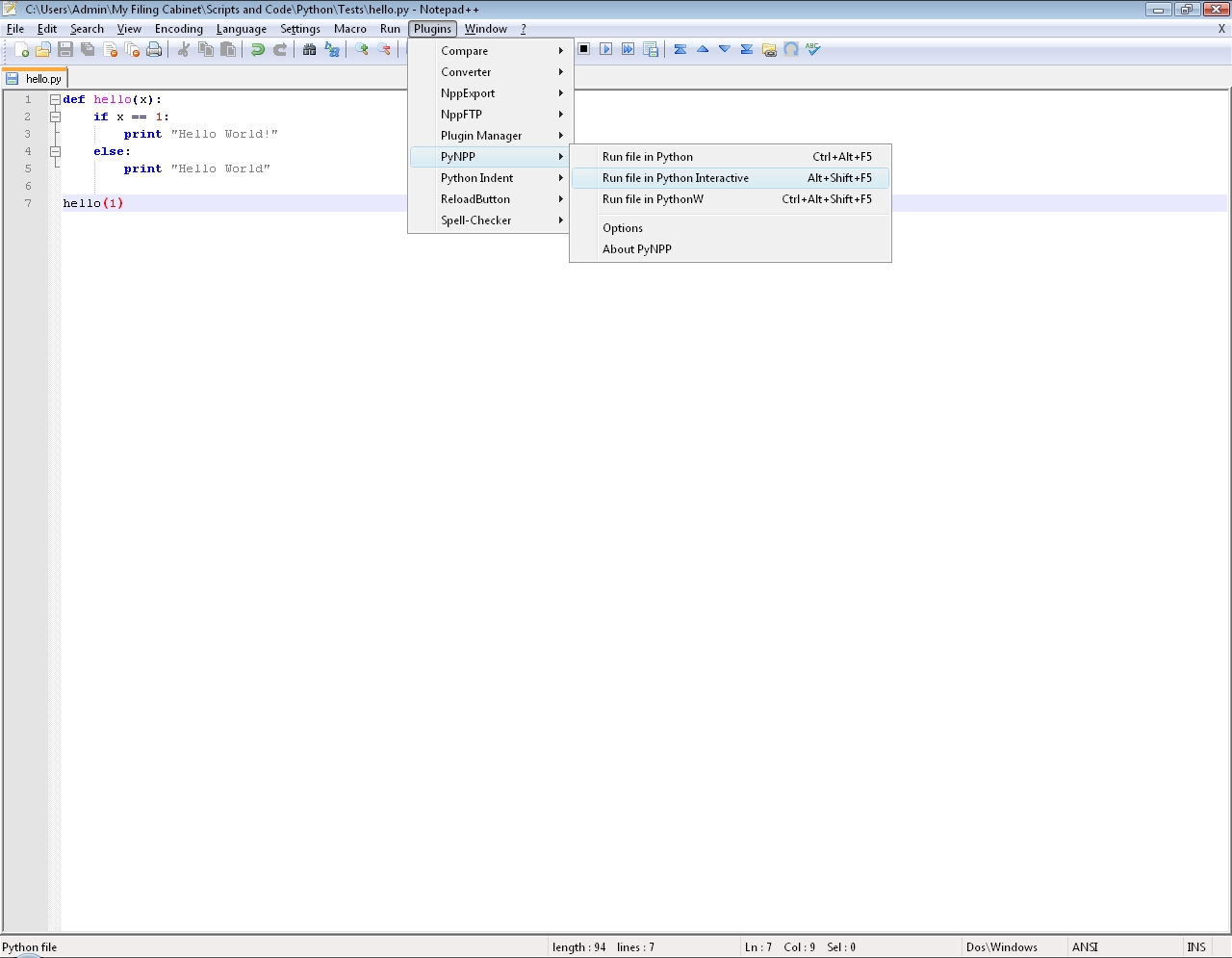
 Pass code to interactive interpreter as separate window
Pass code to interactive interpreter as separate window
Ability to run code interactively in the appropriate interpreter in a separate window a la the PyNPP plugin for Notepad++

I prefer the interpreter to "pop-up" when I want to test my code. I can then take note of an error (Python gives great feedback on errors), close the command prompt window, go back to the code and fix the problem.
I don't like how "Building" in Sublime causes the console to pop-up using up reducing the code you can look at.
With PyNPP I can click in the main window to switch focus back or if I do not need to see the prompt again I can exit it which is much simpler than View->Console. I also find the grey-on-white much harder to read than the white-on-black of the command prompt and it is not representative of what my users will be seeing/using.

 Customize all resources *.sublime-* down to project level
Customize all resources *.sublime-* down to project level
Best Editor. Ever.
I have a request about building system on Sublime Text 2. It happens in my organization to develop C applications for micro-controllers. We have different compilers and linkers and normally different building options to manage.
We have up to half dozen of most used tasks (building variants) for each project. Generally speaking we have few categories where a project falls into.
The most obvious difference is on the "file_regex" property when dealing with more compilers.
Now, it's possible to specify "build_systems" inside the sublime-project, but it does not bring to a desirable result.
Another problem is the key binding for building tasks to launch. I'm not able to assign this binding at project level.
For example the Ctrl+Shift+F9 should execute different commands on different projects, given the purpose of the operation is the same for consistency.
Here is my desire
I would like to specify at project level key combos and building variants like they would appear if done inside the user .sublime-build file.
I thought it was possible to customize all resources down to project level by simply adding the associated .sublime-* file inside the project root (aka where the .sublime-project is stored), but I'm not able to make it work.
I googled enough to think it is not possible yet, maybe I'm wrong.
Thanks!

 Previewing html
Previewing html

 Mac OS X .textclipping support
Mac OS X .textclipping support

 ROBERT P. FUESSL: An incisive and impavid individual committed to serving the public
ROBERT P. FUESSL: An incisive and impavid individual committed to serving the public
Do you want someone to inspire you to become successful?
Then, you should finish reading this article; and get to know a man who achieved many things, such as being included in the prestigious FAA Airmen Certification Database and being the respected vice-president of the American International School of Subic. Yes, challenges came into his life, but that didn't stop him from achieving his goals. He strongly believes that everything in life happens for a good reason, and it teaches us to become a better person and to inspire other people. No one is perfect that's why pencils have erasers.
So, who is this man we're talking about? He is none other than Robert P. Fuessl.
Let us begin with his most daring and challenging career: being a pilot. Perhaps, you've heard about the renowned FAA Airmen Certification Database, right? It's on a different level and the pilots included in its database are the most qualified and best-trained pilots who have met or exceeded the high educational, licensing and medical standards established by the FAA.
Robert is from Landshut, Germany, and as a pilot, he has been recently acknowledged by the Federal Aviation Administration (FAA) for his inclusion in the Airmen Certification Database, a fact which anyone can check in the agency's website.
Seeing a plane crash is a true horror. No wonder the pilot certification standards have progressed dramatically through the years in order to diminish pilot errors. And FAA standards are some of the highest in the world.

 Crown Capital Eco Management Environmental News Updates: Typhoon Haiyan must spur us on to slow climate change
Crown Capital Eco Management Environmental News Updates: Typhoon Haiyan must spur us on to slow climate change
Victims of Typhoon Haiyan queue for food and water in Tacloban city, in the Philippines. Photograph: Erik De Castro/Reuters
The Philippines's Typhoon Haiyan and its appalling death toll is a terrible example of the increasing force of extreme weather events. Will it shatter complacency about climate change, and electrify the laborious UN ministerial negotiations that are taking place in Warsaw? Do not bank on it, but do not despair either.
Hurricane Katrina came and went in 2005, and Gallup found that Americans worried about climate change jumped from 51% to 62%. Since then, recession focused people on survival, and climate worries receded. In Maslow's hierarchy, basic needs always trump the far-off threat. With recovery and Hurricane Sandy, American public concern is rising again, and it's now at 58%.
Our own flash floods in the summer of 2007 cost £3.2bn – part of a pattern of rising storm damage – but the impact was soon eclipsed by the Climategate email scandal casting misplaced doubt on the science, and then by the recession. Public opinion has only just begun to turn around again, with YouGov finding a rising 56% believing in man-made climate change.
Ironically, economic recovery is allowing people to raise their sights to the climate threat, and none too soon. The new report from the UN Intergovernmental Panel on Climate Change assesses a 95% chance that climate change is man-made, a high enough risk to spur action in any other field of public policy.
If you were told that your house was virtually certain to burn down, you would think that an insurance premium costing 2% of your income in 2050 – Lord Stern's economic estimate of the cost of sorting carbon emissions – looked like a steal.
But what about the global warming pause much beloved by sceptics? There are always variations due to solar activity and other effects, but a new study by British and Canadian scientists Kevin Cowtan and Robert G Way casts doubt on any pause. It suggests that the global temperature rise of the last 15 years has been greatly underestimated.
The reason is the data gaps in the weather station network, especially in the Arctic. If you fill these data gaps using satellite measurements, the warming trend is more than doubled, and the pause disappears. The trend of the last decade looks exactly the same as the trend since the 1950s.
The problem is simple. If we are to hold the rise in global temperatures to 2C above pre-industrial levels – the point at which global damage becomes potentially catastrophic – we have to stop increasing our carbon emissions by the end of this decade, and then reduce them. This is still possible, despite the backsliding on the Kyoto protocol begun by the Canadians.
The Japanese, never keen on Kyoto, have announced they are reducing their carbon target due to a phasing out of low-carbon nuclear in the wake of the Fukushima disaster. They have been followed by the new rightwing Australian government, dumping the Labor coalition's flagship carbon tax. Both moves are causing understandable bad feeling among developing countries in Warsaw, but they are not yet fatal. Other countries are ramping up: the new German coalition, for instance, is likely to aim for 40% cuts in carbon emissions by 2030.
Targets are important, and so is the international agreement now promised for the Paris annual meeting in 2015, not least because it would kill the myth in so many countries that only they are tackling climate change. Why inconvenience ourselves when China is building new coal power stations by the month?
The reality is that China and the United States are continuing to take action. China's low-carbon zones are working. Its low-carbon nuclear energy programme is enormous: it is building another 30 reactors to add to its 17. Its renewable energy target is 15% of primary energy consumption by 2020, the same as the UK's modest contribution to the overall EU target of 20%.
The US federal government is tightening emission standards for coal generators. California is the world's twelfth-largest economy, and is responsible for vehicle standards that are driving electrification of cars. BMW's electric car range is a clear response to the inroads that the electric Tesla is making in this key market.
Both solar panels and onshore wind can, in the right sunny or windy conditions, be cheaper ways of generating electricity than fossil fuels. Solar panels are a quarter of their cost in 2008. Industry estimates suggests that solar will be cheaper (without subsidy) than other ways of generating electricity almost everywhere by 2020, and onshore wind even earlier.
But both solar and wind are intermittent, so a key is battery storage, which is still too expensive. With cheap batteries in the loft or the substation, home heat and light using low-carbon electricity will be attractive. It will open up a new path for developing countries, leapfrogging the need for costly grids and big power stations. In transport, batteries provide long ranges and quick charging for an upmarket luxury car like the Tesla, but the price will need to tumble to attract the mid-range Mondeo buyer.
The shape of low-carbon technology is increasingly clear. The issue is keeping up the pace of change to avert disaster. That means a global deal in December 2015 to curb emissions by 2020, however lopsided it may be. The US Senate will not find the two-thirds majority to ratify a treaty, but the Obama administration can and should make commitments backed up by domestic legislation.
A solution also means tackling the remaining obstacles to the electric economy, particularly batteries. As the EU, let's offer big money like the Longitude prize to spur research. Let's do joint EU-US research with real urgency, like the wartime Manhattan project to make the nuclear bomb.
We need to capture and store the carbon emitted by fossil fuels, or they must be competed out of existence. There has never been a change in the capitalist economy as potentially disruptive or which is likely to be so hard fought by vested interests. For the sake of the victims of Haiyan, and other disasters still to come, it can and must happen.
https://www.pinterest.com/alysiapower27/crown-capital-management-jakarta-indonesia/

 PC Speak: Abney and Associates News - Amazon's history should teach us to beware 'friendly' internet giants
PC Speak: Abney and Associates News - Amazon's history should teach us to beware 'friendly' internet giants
TheGuardian.com
When corporate types gather to schmooze at expensive watering holes they talk about competition as an unalloyed public good. It's seen in Darwinian terms – companies engaged in a ceaseless battle for survival, with only the fittest emerging triumphant. But generally the discussion is couched in agreeably vague, general terms. The sordid realities of Darwinian competition – nature red in tooth and claw – are generally eschewed on the golf course and at the poolside.
Except at amazon.com. Like the other titans of the online world – Google, Facebook, Yahoo and to a lesser extent, Microsoft – Amazon is driven by data and algorithms. But not entirely. What many of its customers may not realise is that the results generated by Amazon's search engine are partly determined by promotional fees extracted from publishers. In his book The Everything Store: Jeff Bezos and the Age of Amazon, Brad Stone describes one campaign to exert pressure for better terms on the more vulnerable publishers. It was known internally as the gazelle project, after Bezos suggested "that Amazon should approach these small publishers the way a cheetah would pursue a sickly gazelle". (With a nice Orwellian touch, company lawyers later changed the name to the "small publisher negotiation programme".)
That's a revealing metaphor: capitalism red in tooth and claw. And it's a useful antidote to the soothing PR of the corporations that now dominate our networked world. Up to now, they have succeeded in branding themselves as different in important ways from the bad old industrial behemoths of the past. Google has its much-vaunted "don't be evil" slogan, for example. Facebook just wants to help everyone to hook up to "share" and "like" stuff. (Strangely, there is no "dislike" button on Planet Facebook.) Amazon is fanatically committed to the philosophy that you – the customer – are always right. And so on.
As a public relations posture this branding strategy has been a brilliant success. We loathe, fear or suspect many of the companies that dominate the offline world – energy utilities, oil companies and banks, to name just three sectors. Yet the giants of cyberspace seem to escape such opprobrium. Instead, it seems that we cannot get enough of the "free" services that they offer.
Yet in Darwinian terms these new corporate giants are just the latest stage in the evolution of the public corporation. They exist to create wealth – vast quantities of it – for their founders and shareholders. Their imperative is to grow and achieve dominance in their chosen markets – as well as in others which they now deem to be within their reach. They are as hostile to trade unions, taxation and regulation as John D Rockefeller, JP Morgan and Andrew Carnegie ever were in their day. The only differences are that the new titans employ far fewer people, enjoy higher margins and are less harassed by governments than their predecessors.
These reflections are triggered by a fascinating study of Amazon by George Packer in the New Yorker magazine. Amazon, you will recall, started out as an online bookstore, and most people probably think that it just branched out into selling other stuff as opportunities arose. The company is pathologically secretive about its sales figures, but Packer quotes one estimate that less than 7% of Amazon's annual revenue now comes from books. Indeed, it's now hard to think of anything that one can't buy from it, or from its affiliates. In that sense, it has indeed become "the everything store".
Packer claims that this was Jeff Bezos's plan from the very beginning. Books were simply a good place to start because people don't need to handle the product before they buy and they are easy to ship. In the early days, some astute observers thought that Bezos's ambition was to become the Walmart of the web. But actually compared with Amazon as it is now, Walmart looks like a niche retailer.
Although books are no longer its core business, Amazon still thinks that book publishing is an industry ripe for further creative destruction. In his book Amazonia, James Marcus, a former Amazon editorial employee, describes how Amazon's techie executives viewed book publishers as "antediluvian losers with rotary phones and inventory systems designed in 1968 and warehouses full of crap". Which explains why most publishers privately regard Amazon as a predatory monster, squeezing their margins the way Tesco squeezes farmers. They won't say this in public, though, for fear that the "buy" button will disappear from their books' pages on Amazon sites.
The big question, of course, is what happens if traditional book publishing becomes unviable because of Amazon's power? One answer – the one that keeps some people awake at night – is that Amazon's dominance in the eBook market will lead to it becoming the biggest publisher in the world. The fittest will then have survived. The rest of us will just have to pay its monopoly rents.

 Improve behavior of “Single selection” after “Split into lines”
Improve behavior of “Single selection” after “Split into lines”
If you have some lines selected and then do “Split into lines” you get multiple carets with selections. But when you run “Single selection” right after this, you'd get only first caret and selection and other selections would be lost.
My suggestion: if all of the selections can be merged to one, the resulting selection after running “Single selection” must include all of them. If there are gaps in selections, then all the first selections must be merged and the rest (after the first gap) can be dropped.

 Status bar is not shown until window is moved/resized
Status bar is not shown until window is moved/resized

 Using commands from command line.
Using commands from command line.
Imho it can be nice feature, if there will be ability to make in console something like this:
sublime_text <file name> [<file name>] -c '<Command> <arg>[<arg>]' [<file name> [<file name>] -c '<Command>']

 Regex find to use groups e.g. textBefore(.+)textAfter
Regex find to use groups e.g. textBefore(.+)textAfter
Reges find does not using groups. It just ignores () in search token.
Both Sublime 2 and 3. It would be nice if parenthesis are used, find would select/replace only terms in search groups, and FindAll would select only text in founded groups

 Autocomplete Quotes
Autocomplete Quotes
I would like to see a feature to autocomplete quotes in PHP this way: inside a quoted string, it would automatically insert \"\" when you type ", and ".." when you type " twice.
Example:
$string="Just a string";
Typing " once inside this string would give this:
$string="Just a \"\"string";
Typing " once more would change to:
$string="Just a ".."string";
PHP editor for Windows had this feature and it's the only one I miss in SublimeText :-).
Regards,
Daniel Wey

 Ability to see Symbols while scrolling through MiniMap.
Ability to see Symbols while scrolling through MiniMap.

 Display the 10 most used file in the left panel
Display the 10 most used file in the left panel

 Dr. Robert B. Shearin, MD
Dr. Robert B. Shearin, MD
Dr. Robert B. Shearin, MD
Pediatrics, Capitol Medical Group
http://doctor.webmd.com/doctor/robert-shearin-md-a20c78bc-38ab-49ed-b9cd-32cdaee9e8c4-overview
8401 Connecticut Ave Ste 201
Chevy Chase, MD 20815
Køn: Mand
År i Praksis: 46 år
Talte sprog: Engelsk, Spansk
Dr. Shearin Education & Training
Medical School: University of North Carolina School of Medicine på Chapel Hill
Graduation Dato: 1968
Dr. Shearin s Specialties & Hospital Samarbejdspartnere
Hospital Tillidshverv: Sibley Memorial Hospital
Specialties: Pediatrics, Adolescent Medicine
Dr. Shearin Health Insurance og medlemskaber
Aetna Valg POS II
Aetna Managed Valg POS Open Access
BCBS blå kort PPO
CareFirst BlueChoice Advantage
CareFirst BlueChoice NTWK POS
CareFirst BluePreferred PPO
Cigna HMO
Cigna LocalPlus
Cigna Open Access
Cigna PPO
Great West PPO
UHC valg plus POS
UHC Naviger HMO
UHC Naviger POS
UHC Options PPO

 Removal of status message only after selection or focus changed
Removal of status message only after selection or focus changed
E.g.
sublime.status_message('Hello World', sticky=True)

 python build results line jumping needs extra match group
python build results line jumping needs extra match group
Change
"file_regex": "^[ ]*File \"(...*?)\", line ([0-9]*)",
to
"file_regex": "^[ ]*File \"(...*?)\", line ([0-9]*)([0-9]*)",
And file:line jumps work.

 Automatic * when we press enter for comments
Automatic * when we press enter for comments
/**
*
*/
Automatic * in new line when we press enter for comments inside /** and */

 Highlight tabstop only of column the cursor is in
Highlight tabstop only of column the cursor is in
I love dotted lines highlighting tabs, but they introduce visual clutter too.
It would be perfect if only column the cursor is in would highlight tabs
e.g. if cursor is on the 3rd tab stop, show dotted line for 3rd tab stops, but not 1st,2nd tab stop or 4th tab stop.
That would let me see where current block of code starts/ends, but wouldn't add "stripes" on all of the indentation.

 Robert Shearin, MD
Robert Shearin, MD
http://www.wellness.com/dir/2195234/pediatrician/md/chevy-chase/robert-shearin-capital-medical-group-md
Om Robert Shearin, MD Robert Shearin, MD praksis som en børnelæge i Chevy Chase, MD.Robert Shearin, MD uddannet fra Univ Of NC Chapel Hill Sch Of Med, Chapel Hill Nc 27599.
primær specielle børnelæge
praksis Capital Medical Group
uddannelse Univ Of NC Chapel Hill Sch Of Med, Chapel Hill Nc 27599
træning Walter Reed Army Med Ctr, Pediatrics, Vanderbilt Univ Med Ctr, Pediatrics
TJENESTER
Robert Shearin, MD giver pædiatrisk pleje på 5530 Wisconsin Ave Ste 1125, Chevy Chase, MD 20815 i Chevy Chase, MD 20815.
Børnelæger yde omfattende pleje til spædbørn, børn og unge. De er i stand til at diagnosticere og behandle sygdomme, skader, betingelser og udviklingsmæssige spørgsmål.
Hvis du vil vide mere, eller at lave en aftale med Capital Medical Group i Chevy Chase, MD, kan du ringe (301) 907-3960.
Customer support service by UserEcho


